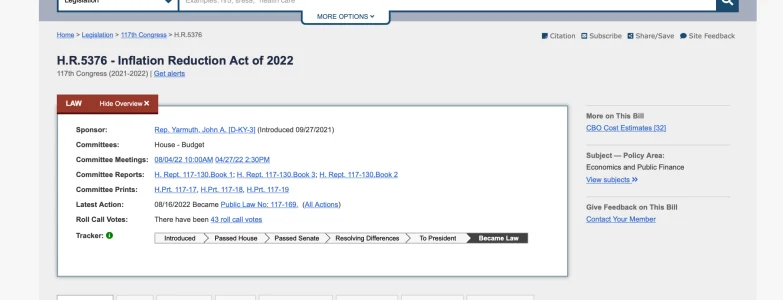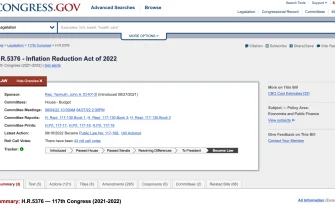16 de Agosto, 2022
H.R.5376 _ Inflation Reduction Act of 2022 Summary. It was passed by the senate on 08/07/2022, and became law on 08/18/2022. You can read the summary below:
TITLE I–COMMITTEE ON FINANCE
Subtitle A–Deficit Reduction
Part 1–Corporate Tax Reform
This bill imposes an alternative minimum tax of 15% of the average annual adjusted financial statement income of domestic corporations (excluding Subchapter S corporations, regulated investment companies, and real estate investment trusts) that exceeds $1 billion over a specified 3-year period. The tax is effective in taxable years beginning after December 31, 2022.
Part 2–Excise Tax on Repurchase of Corporate Stock
The bill imposes a 1% excise tax on the fair market value of stock repurchased by a domestic corporation after 2022, with certain exceptions.
Part 3–Funding the Internal Revenue Service and Improving Taxpayer Compliance
The bill provides additional funding for the Internal Revenue Service for taxpayer services and enforcement, including for operations support, business systems modernization, and the development of a free direct e-file tax return system. It also provides additional funding for the Department of the Treasury Inspector General for Tax Administration, the Office of Tax Policy, the Tax Court, and Treasury departmental offices.
Subtitle B–Prescription Drug Pricing Reform
Part 1–Lowering Prices Through Drug Price Negotiation
The bill requires the Centers for Medicare & Medicaid Services (CMS) to negotiate the prices of certain prescription drugs under Medicare beginning in 2026.
Specifically, the CMS must negotiate maximum prices for brand-name drugs that do not have other generic equivalents and that account for the greatest Medicare spending. The CMS must negotiate the prices of 10 drugs in 2026, 15 drugs in 2027 and 2028, and 20 drugs in 2029 and each year thereafter. Drug manufacturers that fail to comply with negotiation requirements are subject to civil penalties and excise taxes.
The bill provides funds for FY2022 for the CMS to implement this program.
Part 2–Prescription Drug Inflation Rebates
In addition, the bill requires drug manufacturers to issue rebates to the CMS for brand-name drugs without generic equivalents under Medicare that cost $100 or more per year per individual and for which prices increase faster than inflation. Manufacturers that fail to comply are subject to civil penalties.
The bill provides funds through FY2031 for the CMS to implement the rebate programs.
Part 3–Part D Improvements and Maximum Out-of-Pocket Cap for Medicare Beneficiaries
The bill eliminates beneficiary cost-sharing above the annual out-of-pocket spending threshold under the Medicare prescription drug benefit beginning in 2024 and caps annual out-of-pocket spending at $2,000 in 2025 (with annual adjustments thereafter). It also establishes a program under which drug manufacturers provide discounts to beneficiaries who have incurred costs above the annual deductible beginning in 2025.
The bill provides funds through FY2031 for the CMS to implement these changes and requirements.
The bill also establishes a process through which certain beneficiaries may have their monthly out-of-pocket costs capped and paid in monthly installments beginning in 2025; it provides funds for FY2023 for the CMS to implement this process.
Part 4–Continued Delay of Implementation of Prescription Drug Rebate Rule
The bill further delays until 2032 implementation of a Department of Health and Human Services rule relating to the treatment of certain Medicare prescription drug benefit rebates from drug manufacturers for purposes of federal anti-kickback laws.
Part 5–Miscellaneous
The bill establishes a series of additional programs and requirements relating to coverage under the Medicare prescription drug benefit and other programs.
For example, the bill eliminates cost-sharing under the Medicare prescription drug benefit for adult vaccines that are recommended by the Advisory Committee on Immunization Practices. It also requires coverage, without cost-sharing, of such vaccines under Medicaid and the Children’s Health Insurance Program (CHIP).
In addition, the bill caps cost-sharing under the Medicare prescription drug benefit for a month’s supply of covered insulin products at (1) for 2023 through 2025, $35; and (2) beginning in 2026, $35, 25% of the government’s negotiated price, or 25% of the plan’s negotiated price, whichever is less. The bill provides funds for FY2022 for the CMS to implement these provisions.
Subtitle C–Affordable Care Act Subsidies
The bill extends through 2025 certain adjustments and expansions of the premium tax credit, including to allow taxpayers with income above 400% of the federal poverty line to qualify for the credit.
Subtitle D–Energy Security
The bill modifies and extends through 2024 tax credits (1) for producing electricity from renewable resources, specifically for wind, biomass, geothermal and solar, landfill gas, trash, qualified hydropower, and marine and hydrokinetic resources; (2) for investment in certain energy properties (e.g., solar, fuel cells, waste energy recovery, combined heat and power, small wind property, and microturbine property); and (3) for alternative fuels and fuel mixtures, and biodiesel and renewable diesel.
The bill creates new tax credits for (1) qualifying zero-emission nuclear power produced and sold after 2023, (2) the sale or mixture of sustainable aviation fuel beginning in 2023, (3) the production of clean hydrogen, (4) the production of clean electricity and for investment in zero-emissions electricity generation facilities or energy storage technology, (5) domestic clean fuel production beginning in 2025, and (6) the domestic production and sale of qualifying solar and wind components.
The bill modifies and extends through 2032 (1) the tax credit for nonbusiness energy property and increases its rate to 30%, with certain limitations; (2) the new energy efficient home credit; and (3) the tax credit for alternate fuel refueling property expenditures.
The bill modifies requirements for the tax deduction for energy efficient commercial buildings.
The bill creates a new credit for commercial clean vehicles and modifies the refundable tax credit for the purchase of plug-in electric vehicles and previously-owned electric vehicles.
The bill permanently reinstates the Hazardous Substance Superfund financing rate for certain excise taxes, including the excise tax on domestic crude oil and imported petroleum products at the rate of 16.4 cents per barrel in 2023, adjusted annually for inflation.
The bill makes permanent the increased rate of the coal excise tax for funding the Black Lung Disability Trust Fund.
The bill increases the amount of the research tax credit that may be applied against the payroll tax liabilities of certain small businesses.
The bill reinstates the current suspension until 2025 of the tax deduction for state and local taxes and extends the limitation on excess business losses of noncorporate taxpayers.
TITLE II–COMMITTEE ON AGRICULTURE, NUTRITION, AND FORESTRY
Subtitle A–General Provisions
The bill provides funding to the Department of Agriculture (USDA) for a variety of programs related to conservation and renewable energy.
Subtitle B–Conservation
Specifically, the bill provides funding to USDA for voluntary conservation programs, such as the environmental quality incentives program, the conservation stewardship program, the agricultural conservation easement program, and the regional conservation partnership program.
It also provides funding to USDA’s Natural Resources Conservation Service for (1) conservation technical assistance; and (2) a program to quantify carbon sequestration and carbon dioxide, methane, and nitrous oxide emissions.
Subtitle C–Rural Development and Agricultural Credit
In addition, the bill provides funding to USDA for several programs, such as the Rural Energy for America Program, that support the generation, storage, and use of renewable energy in rural communities.
Subtitle D–Forestry
The bill also provides funding to USDA for the National Forest System, including funding for forest restoration, wildfire prevention, and related activities. Further, the bill provides funding to USDA for programs that award grants to owners of state or private forests for climate mitigation, forest resilience, or related activities.
TITLE III–COMMITTEE ON BANKING, HOUSING, AND URBAN AFFAIRS
The bill provides additional funding for the President to carry out activities under the Defense Production Act of 1950. That act confers on the President a broad set of authorities to influence domestic industry in order to provide essential materials and goods for the national defense.
In addition, the bill provides funding to the Department of Housing and Urban Development for loans and grants to fund projects that address affordable housing and climate change issues, such as projects designed to increase the energy or water efficiency of affordable housing.
TITLE IV–COMMITTEE ON COMMERCE, SCIENCE, AND TRANSPORTATION
The bill provides funding for coastal communities, coastal and marine habitats, weather forecasting, and aviation technology.
For example, the bill provides funding to the National Oceanic and Atmospheric Administration (NOAA), including funding for
- coastal communities so they can prepare for extreme storms and other changing climate conditions,
- NOAA facilities (e.g., fisheries laboratories and national marine sanctuaries facilities),
- weather research and forecasting innovations, and
- acquiring a hurricane hunter aircraft.
In addition, the bill provides funding to the Department of Transportation for a program that awards grants for projects that (1) produce, transport, blend, or store sustainable aviation fuel; or (2) develop, demonstrate, or apply low-emission aviation technologies.
TITLE V–COMMITTEE ON ENERGY AND NATURAL RESOURCES
Subtitle A–Energy
Part 1–General Provisions
The bill provides funding to the Department of Energy (DOE) for a variety of programs concerning energy rebates, energy efficiency in buildings, electric transmissions, advanced industrial facilities, and other energy matters.
Part 2–Residential Efficiency and Electrification Rebates
For example, the bill provides funding to DOE for a HOMES rebate program that awards grants to state energy offices. Under the program, states must provide rebates to homeowners and aggregators for certain whole-house energy saving retrofits made for low- and moderate-income households.
In addition, funding is provided to DOE for a high-efficiency electric home rebate program that awards grants to state energy offices and Indian tribes. Under the program, rebates must be given for qualified electrification projects in low- or moderate-income households.
Part 3–Building Efficiency and Resilience
The bill also provides funding to DOE for grants to states and local governments to adopt and implement building codes for (1) residential buildings that meet or exceed the 2021 International Energy Conservation Code, or (2) commercial buildings that meet or exceed the ANSI/ASHRAE/IES Standard 90.1–2019.
Part 4–DOE Loan and Grant Programs
The bill provides funding for specified DOE loan programs, including
- certain loans issued under the Energy Policy Act of 2005;
- loans for facilities that manufacture advanced vehicles that emit either a low amount of or no amount of greenhouse gas emissions; and
- loans for the domestic production of efficient hybrid, plug-in electric hybrid, plug-in electric drive, and hydrogen fuel cell electric vehicles.
The bill also provides funding to support financing of energy infrastructure projects, including projects to replace nonoperational energy infrastructure or reduce the emissions of energy infrastructure.
Part 5–Electric Transmission
The bill provides funding to DOE for a program that provides loans for the construction or modification of electric transmission facilities that are located within a national interest electric transmission corridor. Further, DOE is authorized to make grants to facilitate the siting of interstate electricity transmission lines.
In addition, the bill provides funding to DOE for interregional and offshore wind electricity transmission planning, modeling, and analysis.
Part 6–Industrial
The bill also provides funding for DOE’s Office of Clean Energy Demonstrations to carry out the advanced industrial facilities deployment program. Under the program, the office must deploy advanced industrial technology to accelerate the reduction and elimination of greenhouse gas emissions at industrial facilities.
Part 7–Other Energy Matters
In addition, the bill provides funding for other energy matters, such as infrastructure projects for DOE’s national laboratories as well as efforts to increase the availability of high-assay low-enriched uranium, a fuel used in advanced nuclear reactors.
Subtitle B–Natural Resources
Part 1–General Provisions
The bill provides funding for natural resources, water supplies, the Office of Insular Affairs, leases to develop energy on federal land, and other related issues.
Part 2–Public Lands
The bill provides funding to the Department of Interior to carry out projects for (1) the conservation, protection, and resiliency of lands and resources administered by the National Park Service (NPS) and the Bureau of Land Management (BLM); and (2) conservation and ecosystem and habitat restoration projects on lands administered by the NPS and the BLM.
It also provides funding to the NPS to hire more employees and carry out priority deferred maintenance projects.
Part 3–Drought Response and Preparedness
The bill provides funding to the BLM for water supply projects, projects to cover water conveyance facilities with solar panels, and drought mitigation in western states.
Part 4–Insular Affairs
The bill provides funding to Interior’s Office of Insular Affairs. The office must use the funding to provide technical assistance for climate change planning, mitigation, adaptation, and resilience to United States Insular Areas (i.e., American Samoa, Northern Mariana Islands, Guam, Puerto Rico, and the U.S. Virgin Islands).
Part 5–Offshore Wind
The bill provides for the lease of federal land in the Outer Continental Shelf (OCS) for offshore wind development. Specifically, Interior may issue leases, easements, and rights-of-way in the OCS to produce, transport, store, or transmit energy from sources other than oil and gas (e.g., offshore wind energy sources) in land areas previously withdrawn from leasing.
The bill (1) expands the definition of the OCS to include land that is within the U.S. exclusive economic zone and adjacent to any territory of the United States, and (2) allows Interior to conduct wind lease sales that are in such areas if the leases meet specified criteria.
Part 6–Fossil Fuel Resources
In addition, the bill modifies several provisions related to oil and gas leasing on public lands. For example, it increases the minimum royalty rates for oil and gas leases on federal land as well as offshore land in the OCS. It also increases rental rates and minimum bidding standards for onshore oil and gas leases and establishes a new fee that must be paid by any person who nominates public lands for such leasing. Further, it requires royalties to be paid for methane gas extracted from federal lands, including offshore lands as specified by the bill.
Part 7–United States Geological Survey
The bill provides funding for the United States Geological Survey to produce, collect, disseminate, and use 3D elevation data.
Subtitle C–Environmental Reviews
The bill provides funding to DOE, the Federal Energy Regulatory Commission, and Interior for environmental reviews as specified under the bill.
TITLE VI–COMMITTEE ON ENVIRONMENT AND PUBLIC WORKS
Subtitle A–Air Pollution
The bill provides funding to the Environmental Protection Agency (EPA) to establish a greenhouse gas reduction fund and to support several programs that provide financial incentives to reduce greenhouse gas emissions and other air pollution emissions. For example, the bill provides incentives to
- replace eligible medium-duty vehicles (e.g., school buses) and heavy-duty vehicles (e.g., garbage trucks) with zero-emission vehicles,
- purchase or install equipment and technology to reduce pollution at ports,
- identify and reduce emissions from diesel engines,
- monitor air pollution and greenhouse gases,
- encourage states to adopt and implement greenhouse gas and zero-emission standards for mobile sources, and
- reduce methane emissions from petroleum and natural gas systems.
The bill also provides funding to implement the renewable fuels programs and the American Innovation and Manufacturing Act.
Subtitle B–Hazardous Materials
In addition, the bill provides funding to the EPA for environmental and climate justice block grants that benefit disadvantaged communities.
Subtitle C–United States Fish and Wildlife Service
The bill provides funding to the United States Fish and Wildlife Service (USFWS) to develop and implement recovery plans for the conservation and survival of endangered species and threatened species.
It also provides funding to USFWS to rebuild and restore units of the National Wildlife Refuge System and state wildlife management areas by (1) addressing the threat of invasive species, (2) increasing the resiliency and capacity of habitats and infrastructure to withstand weather events, and (3) reducing the amount of damage caused by weather events.
Subtitle D–Council on Environmental Quality
The bill provides funding to the Council on Environmental Quality, including funding for (1) collecting data related to environmental and climate issues, (2) tracking disproportionate burdens and cumulative impacts, and (3) supporting efforts to ensure that any mapping or screening tool is accessible to community-based organizations and community members.
Subtitle E–Transportation and Infrastructure
This bill provides funding to the Federal Highway Administration and to the General Services Administration. Specifically, it provides funding to the Federal Highway Administration for the neighborhood access and equity grant program, the environmental review of transportation projects, and grants for the use of low-carbon construction materials and products on federally funded transportation projects.
In addition, it provides funding to the Federal Building Fund for (1) converting and constructing federal facilities to high-performance green buildings, (2) acquiring and installing low-carbon materials and products in the construction of federal buildings, and (3) emerging and sustainable technologies as well as related sustainability and environmental programs.
TITLE VII–COMMITTEE ON HOMELAND SECURITY AND GOVERNMENTAL AFFAIRS
This bill provides funding for the oversight of this act as well as a variety of environmental programs, such as funding to
- the Department of Homeland Security for implementing sustainability and environmental programs,
- the U.S. Postal Service for purchasing zero-emission delivery vehicles and installing related infrastructure, and
- the Federal Emergency Management Agency so it may provide assistance under the Robert T. Stafford Disaster Relief and Emergency Assistance Act for costs associated with low-carbon building materials as well as incentives that encourage low-carbon and net-zero energy projects.
TITLE VIII–COMMITTEE ON INDIAN AFFAIRS
This bill provides funding to assist Indian tribes address climate change, including funding to
- the Bureau of Indian Affairs and the Office of Native Hawaiian Relations for climate resilience and adaptation programs,
- the Bureau of Indian Affairs for a tribal electrification program, and
- the BLM for providing emergency drought relief to Indian tribes located in the western United States.











